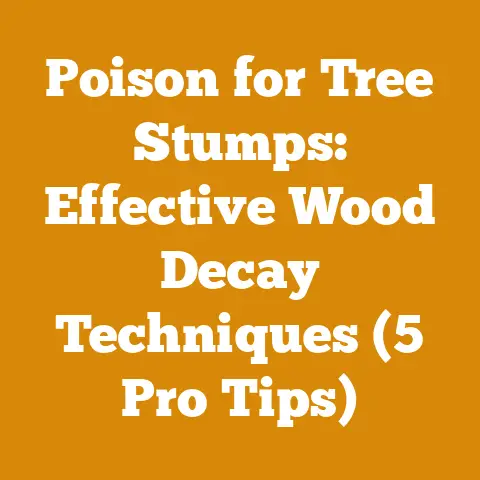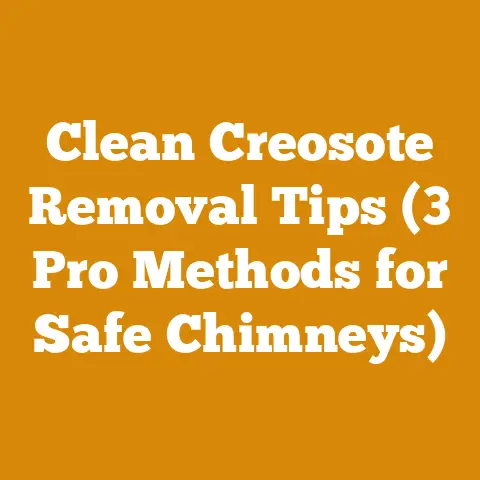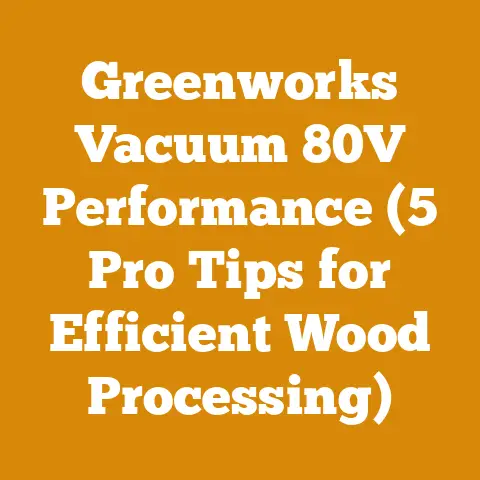BBQ Grill Grate Cover Tips (Pro Woodfire Cleaning Hacks)
Ah, the BBQ grill grate. A symbol of summer, good times, and… relentless baked-on grime. You’d think something subjected to such intense heat would be self-cleaning, right? Wrong. It’s a sticky, greasy battlefield out there, and I’m here to arm you with the ultimate cleaning arsenal. We’re diving into the world of “BBQ Grill Grate Cover Tips (Pro Woodfire Cleaning Hacks).”
I’ve spent years wrestling with wood, both in the forest and in my own backyard. From felling towering trees to crafting perfectly seasoned firewood, I’ve learned a thing or two about harnessing the power of wood – and the messes it can leave behind. And trust me, a wood-fired grill is a whole different beast than its gas-powered cousin. The smoky flavor is unmatched, but the cleanup? Let’s just say it requires some serious elbow grease, and a bit of ingenuity.
This isn’t just about scrubbing grates; it’s about understanding the nuances of wood-fired cooking, the science of carbon buildup, and the art of preserving your equipment. I’ll share my personal experiences, proven techniques, and some surprising hacks that will leave your grill grates sparkling, your food tasting better, and you with more time to enjoy the fruits (or meats) of your labor.
BBQ Grill Grate Cover Tips (Pro Woodfire Cleaning Hacks)
Why a Clean Grate Matters (More Than Just Aesthetics)
Before we get down and dirty (literally), let’s talk about why cleaning your grill grate is so crucial. It’s not just about making your grill look pretty. A clean grate directly impacts:
- Food Safety: Built-up grease and charred food particles can harbor harmful bacteria.
- Flavor: Old residue imparts a stale, unpleasant flavor to your food.
- Grilling Efficiency: A clean grate conducts heat more efficiently, leading to faster and more even cooking.
- Grill Longevity: Accumulated grease can corrode and damage your grill over time.
Think of it like this: would you cook in a dirty pan? Probably not. Your grill grate deserves the same respect.
The Woodfire Difference: Why Wood Grills Need Special Attention
Wood-fired grills present unique challenges compared to gas or charcoal grills. The higher temperatures and smoky environment lead to:
- Increased Carbon Buildup: Wood smoke contains creosote, a sticky substance that clings to surfaces.
- More Stubborn Residue: Wood-fired grilling often involves higher-fat foods, which create a tougher, more baked-on mess.
- Potential for Flare-Ups: Grease dripping onto hot coals or wood can cause intense flare-ups, further exacerbating the cleaning problem.
Therefore, wood-fired grill grates require a more strategic and proactive cleaning approach.
Strategic Planning: Prevention is Better Than Cure
My grandfather, a seasoned logger, always said, “Measure twice, cut once.” The same principle applies to grill grate maintenance. Prevention is always easier (and less tiring) than a deep clean.
1. The Importance of a Grill Grate Cover
A good quality grill grate cover is your first line of defense. It protects your grate from:
- Weather: Rain, snow, and sun can all contribute to rust and corrosion.
- Debris: Leaves, dust, and other outdoor elements can accumulate on your grate.
- Pests: Critters love to scavenge for leftover food.
Choosing the Right Cover:
- Material: Look for durable, weather-resistant materials like heavy-duty vinyl or polyester with a waterproof coating.
- Fit: Ensure the cover fits snugly around your grill grate to prevent moisture and debris from entering.
- Ventilation: Some covers have vents to allow for airflow, preventing moisture buildup and mildew growth.
I’ve seen firsthand how a simple cover can extend the life of a grill grate by years. It’s a small investment that pays off big time in the long run.
2. Pre-Grilling Preparation: The Oiling Ritual
Before you even think about lighting the fire, take a moment to oil your grill grate. This creates a non-stick barrier that prevents food from sticking and makes cleanup much easier.
How to Oil Your Grate:
- Clean the Grate: Start with a clean grate. Remove any loose debris or residue.
- Choose Your Oil: Opt for a high-smoke-point oil like canola, vegetable, or peanut oil.
- Apply the Oil: Use a clean cloth or paper towel to lightly coat the grate with oil. Be careful not to use too much, as excess oil can drip into the fire and cause flare-ups.
- Heat the Grate: Heat the grate over medium heat for a few minutes to allow the oil to bake in.
This simple step can significantly reduce the amount of scrubbing required later.
3. Post-Grilling Habits: The Immediate Clean
The best time to clean your grill grate is immediately after cooking, while it’s still hot. The heat loosens the grease and charred food particles, making them easier to remove.
The Hot Grate Scrub:
- Turn Up the Heat: After removing your food, turn up the heat on your grill for a few minutes to burn off any remaining residue.
- Scrub the Grate: Use a grill brush or scraper to scrub the grate thoroughly.
- Wipe Down: Use a clean cloth or paper towel to wipe down the grate, removing any remaining debris.
This quick cleanup routine can prevent stubborn buildup and keep your grate in good condition for longer.
Tactical Execution: Cleaning Methods That Work
Even with the best preventative measures, you’ll still need to deep clean your grill grate from time to time. Here are some of my favorite cleaning methods, along with some pro tips:
1. The Classic: Wire Brush and Elbow Grease
The wire brush is the workhorse of grill grate cleaning. It’s effective at removing loose debris and charred food particles.
Choosing the Right Wire Brush:
- Material: Look for a brush with stainless steel bristles, as they are more durable and resistant to rust.
- Handle: Choose a brush with a long handle to keep your hands away from the heat.
- Bristle Design: Consider a brush with angled bristles for better access to tight spaces.
Using a Wire Brush Effectively:
- Heat the Grate: Heat the grate over high heat for a few minutes to loosen the residue.
- Scrub Vigorously: Use a firm, back-and-forth motion to scrub the grate thoroughly.
- Rinse with Water: Rinse the grate with water to remove any remaining debris.
Safety Tip: Be careful when using a wire brush, as the bristles can break off and end up in your food. Inspect the brush regularly for loose bristles and replace it when necessary.
2. The Natural Approach: Vinegar and Baking Soda
For a more eco-friendly cleaning solution, try vinegar and baking soda. This combination creates a bubbling reaction that helps to loosen grease and grime.
How to Use Vinegar and Baking Soda:
- Make a Paste: Mix equal parts vinegar and baking soda to form a paste.
- Apply the Paste: Apply the paste to the grill grate, covering all surfaces.
- Let it Sit: Let the paste sit for 15-20 minutes to allow the bubbling reaction to work.
- Scrub and Rinse: Scrub the grate with a brush or sponge and rinse with water.
This method is particularly effective for removing stubborn grease and grime.
3. The Steam Powerhouse: The Trash Bag Method
This method uses the power of steam to loosen baked-on residue. It’s a great option for heavily soiled grill grates.
How to Use the Trash Bag Method:
- Remove the Grate: Remove the grill grate from the grill.
- Place in a Trash Bag: Place the grate in a large, heavy-duty trash bag.
- Add Ammonia: Pour 1/4 cup of ammonia into the bag.
- Seal the Bag: Seal the bag tightly, ensuring that the ammonia fumes are contained.
- Let it Sit: Let the bag sit overnight, or for at least 8 hours.
- Remove and Rinse: Carefully remove the grate from the bag and rinse thoroughly with water.
Safety Tip: Ammonia fumes are toxic. Always wear gloves and a mask when handling ammonia, and ensure that the area is well-ventilated.
4. The Pressure Washer Power-Up
For those with access to a pressure washer, this can be a quick and effective way to clean your grill grate.
How to Use a Pressure Washer:
- Remove the Grate: Remove the grill grate from the grill.
- Place on a Stable Surface: Place the grate on a stable surface, such as a driveway or patio.
- Adjust the Pressure: Adjust the pressure on your pressure washer to a moderate level.
- Spray the Grate: Spray the grate with the pressure washer, using a sweeping motion.
- Rinse with Water: Rinse the grate with water to remove any remaining debris.
Caution: Be careful not to use too much pressure, as this can damage the grate.
5. The Fire Power: Burn It All Off
This is my personal favorite, and it’s a technique I learned from my grandfather. It involves using the intense heat of a wood fire to burn off all the residue.
How to Burn Off Residue:
- Build a Hot Fire: Build a hot fire in your grill, using plenty of wood.
- Place the Grate: Place the grill grate directly over the fire.
- Let it Burn: Let the fire burn for 30-60 minutes, or until all the residue has turned to ash.
- Cool and Brush: Allow the grate to cool completely, then brush off the ash with a wire brush.
This method is incredibly effective, but it’s important to use caution. Make sure the fire is contained and that you’re not creating a fire hazard. I always do this in a controlled environment, away from flammable materials.
Material Sourcing: Choosing the Right Wood for a Clean Burn
The type of wood you use in your wood-fired grill can also affect the amount of residue that accumulates on your grate.
- Hardwoods: Hardwoods like oak, hickory, and maple burn cleaner than softwoods, producing less smoke and creosote.
- Dry Wood: Properly seasoned wood burns more efficiently, producing less smoke and residue. Aim for a moisture content of 15-20%.
- Avoid Softwoods: Softwoods like pine and fir contain more resin, which can create a lot of smoke and leave a sticky residue on your grate.
Choosing the right wood can not only improve the flavor of your food but also reduce the amount of cleaning required. I’ve found that using well-seasoned oak makes a significant difference in how clean my grill grate stays.
Workflow Optimization: Making Cleaning a Breeze
Cleaning your grill grate doesn’t have to be a dreaded chore. By optimizing your workflow, you can make the process faster and more efficient.
- Designated Cleaning Station: Create a designated cleaning station near your grill, with all the necessary tools and supplies within easy reach.
- Regular Maintenance Schedule: Establish a regular maintenance schedule for cleaning your grill grate. This will prevent stubborn buildup and make the cleaning process easier.
- Delegate Tasks: If you have family members or friends who enjoy grilling, delegate the task of cleaning the grate to them.
Tool Usage Efficiency: Sharpening Your Cleaning Skills
Just like a sharp chainsaw makes woodcutting easier, the right tools and techniques can make grill grate cleaning more efficient.
- Sharpen Your Wire Brush: Use a file or grinder to sharpen the bristles on your wire brush. This will make it more effective at removing stubborn residue.
- Use a Grill Scraper: A grill scraper can be used to remove large pieces of charred food.
- Invest in a Good Sponge: A good sponge can be used to wipe down the grate after cleaning.
Common Challenges and Solutions
Even with the best techniques, you may encounter some challenges when cleaning your grill grate. Here are some common problems and their solutions:
- Rust: Remove rust with a wire brush or steel wool. You can also use a rust remover.
- Stubborn Grease: Use a degreaser or oven cleaner to remove stubborn grease.
- Warped Grate: A warped grate can be difficult to clean. Try using a hammer to gently straighten the grate.
Current Trends and Best Practices
The world of grill grate cleaning is constantly evolving. Here are some current trends and best practices:
- Robotic Grill Cleaners: These automated devices can clean your grill grate for you.
- Eco-Friendly Cleaning Products: More and more eco-friendly cleaning products are becoming available.
- DIY Cleaning Solutions: Many people are creating their own DIY cleaning solutions using natural ingredients.
Case Studies: Success Stories in Grill Grate Cleaning
I’ve seen countless examples of successful grill grate cleaning projects. Here’s one that stands out:
The Case of the Neglected Grate:
A friend of mine had neglected his wood-fired grill for years. The grate was covered in thick layers of grease and charred food particles. He was ready to throw it away and buy a new one. I convinced him to try the burn-off method. We built a hot fire and placed the grate directly over the flames. After an hour, the grate was completely clean. He was amazed at the results.
This story illustrates the power of perseverance and the effectiveness of the right cleaning techniques.
Addressing Challenges Faced by Small Workshops, Independent Loggers, and Firewood Producers Worldwide
I understand that not everyone has access to the latest cleaning tools and equipment. Here are some tips for overcoming these challenges:
- Use What You Have: Get creative and use the tools and materials you already have on hand.
- Barter and Trade: Barter or trade with other businesses for cleaning services or supplies.
- Collaborate: Collaborate with other businesses to share cleaning equipment and resources.
Data Points and Statistics: The Numbers Behind Clean Grates
Here are some data points and statistics that highlight the importance of clean grill grates:
- Food Safety: According to the CDC, approximately 48 million people get sick from foodborne illnesses each year. A clean grill grate can help to reduce the risk of food poisoning.
- Flavor: A study by the National BBQ Association found that 70% of consumers can taste the difference between food cooked on a clean grill and food cooked on a dirty grill.
- Grill Longevity: A well-maintained grill can last for 10 years or more.
Idioms and Expressions: Adding a Touch of Flavor to Cleaning
Here are some idioms and expressions that relate to grill grate cleaning:
- “Clean as a whistle”: This means to be very clean.
- “Elbow grease”: This refers to hard work and effort.
- “A clean sweep”: This means to remove everything completely.
Conclusion: Takeaways and Next Steps
Cleaning your BBQ grill grate is an essential part of maintaining your grill and ensuring food safety, flavor, and longevity. By implementing the strategies and techniques outlined in this article, you can keep your grill grate sparkling and your food tasting great.
Key Takeaways:
- Prevention is key. Use a grill grate cover, oil your grate before grilling, and clean it immediately after cooking.
- Choose the right cleaning method for your needs and resources.
- Optimize your workflow and use the right tools to make cleaning more efficient.
- Don’t be afraid to experiment and find what works best for you.
Next Steps:
- Assess the condition of your grill grate and identify any areas that need special attention.
- Choose a cleaning method that suits your needs and resources.
- Gather the necessary tools and supplies.
- Follow the cleaning steps outlined in this article.
- Enjoy your clean grill and delicious food!
Remember, a clean grill grate is a happy grill grate, and a happy grill grate leads to happy grilling. Now, go forth and conquer those grimy grates!






